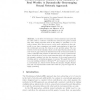Free Online Productivity Tools
i2Speak
i2Symbol
i2OCR
iTex2Img
iWeb2Print
iWeb2Shot
i2Type
iPdf2Split
iPdf2Merge
i2Bopomofo
i2Arabic
i2Style
i2Image
i2PDF
iLatex2Rtf
Sci2ools
EWLR
1999
Springer
1999
Springer
Toward Seamless Transfer from Simulated to Real Worlds: A Dynamically-Rearranging Neural Network Approach
In the field of evolutionary robotics artificial neural networks are often used to construct controllers for autonomous agents, because they have useful properties such as the ability to generalize or to be noise–tolerant. Since the process to evolve such controllers in the real– world is very time–consuming, one usually uses simulators to speed up the evolutionary process. By doing so a new problem arises: The controllers evolved in the simulator show not the same fitness as those in the real–world. A gap between the simulated and real environments exists. In order to alleviate this problem we introduce the concept of neuromodulators, which allows to evolve neural networks which can adjust not only the synaptic weights, but also the structure of the neural network by blocking and/or activating synapses or neurons. We apply this concept to a peg–pushing problem for KheperaT M and compare our method to a conventional one, which evolves directly the synaptic weights. Simulat...
| Added | 04 Aug 2010 |
| Updated | 04 Aug 2010 |
| Type | Conference |
| Year | 1999 |
| Where | EWLR |
| Authors | Peter Eggenberger, Akio Ishiguro, Seiji Tokura, Toshiyuki Kondo, Yoshiki Uchikawa |
Comments (0)

